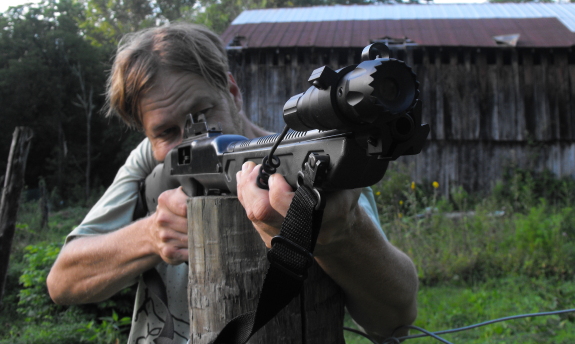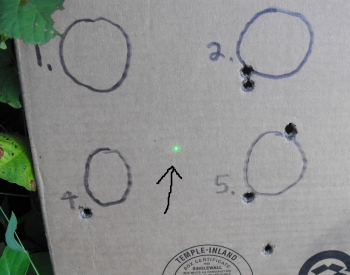
NcSTAR red/green laser review


The new NcSTAR
red/green laser is now
mounted and ready for action.
It was easy to move the laser
dot to a desired location with just 2 adjustment screws.
The hard part will be
learning how to work within the limitations of the laser. I can already
tell you need to be lined up pretty straight otherwise the laser tends
to drift the further you tilt the angle up or down. There's also an 8mm
difference in the point of impact at 20 yards when you switch from
green to red, with the difference increasing as you increase the
distance. I think that can be solved by just using the green all the
time.
With a little practice I
think this laser aid can help to improve our accuracy under certain
conditions, but I think we should also be ready to take a shot without
the laser when the angle needs to be tilted beyond its range of
effective use.
Want more in-depth information? Browse through our books.
Or explore more posts by date or by subject.
About us: Anna Hess and Mark Hamilton spent over a decade living self-sufficiently in the mountains of Virginia before moving north to start over from scratch in the foothills of Ohio. They've experimented with permaculture, no-till gardening, trailersteading, home-based microbusinesses and much more, writing about their adventures in both blogs and books.
Want to be notified when new comments are posted on this page? Click on the RSS button after you add a comment to subscribe to the comment feed, or simply check the box beside "email replies to me" while writing your comment.

That looks like a big lump up front!
Why not fit a scope instead of a laser? My dad had a scope fitted to his old Diana 4.5 mm airgun, and it worked like a charm. The divisions on the vertical line in the scope helped a lot to correct for bullet drop (after callibrating it once), which a laser doesn't. And a scope works without batteries.
A simple scope is not that expensive anymore. IIRC, brazing on the mount (because the airgun only had iron sights) was more expensive that the scope itself.
I agree that a scope looks like a more accurate aid and perhaps we'll go that direction in the future.
Anna was quick to do the math before I even got it installed. The only way the laser would be perfect would be if it shot directly out of the barrel.
It's not perfect...but if we learn it's limitations it might help, but it's not the quick fix I had hoped it might be when I was reading about it online.
Maybe someone should invent a new type of gun that allows for a laser to come out of the barrel without blocking the bullet....maybe with mirrors?
Although for a deer rifle I would recommend a good inexpensive scope. The only concern I would have with your laser is the mounting. It looks like your mounting is near the end of the barrel. There is a lot of recoil forces there not to mention knocking the barrel on a tree limb or something. How accurate will it be after 10 shoots or after a year of storage? Can you mount it on the gun's scope mounts? Using a laser you shouldn't have to use sites, just point and shoot but can be hard to see at a distance.
As far as angles between the laser and bullet. You have the same difference with a scope. This is where knowing bullet trajectory comes in handy. Your bullet leaves the barrel at the beginning of an arch. At some point it will cross the level plain of the scope or laser. Then reach the apex of the arch and later cross the level plain again on its way down. Where these intersection points are depends on many variables including distance you sight in your gun. Then it is up to the shooter to gauge where to place the bullet. If all you will be shooting is within the 100 yard range, just sight in at 30 yards and don't worry about trajectory.
But this only works if your laser or scope is mounted directly above your barrel, otherwise there will only be one intersection and the bullet will just continue to widen the gap. Just think about having the laser under the barrel. The bullet fires downward in relation to the level line of the laser, intersects the laser, and just continues to fall from there. This leaves you with a more extreme vertical variable than top mount. Side mounting makes it even more complicated by throwing in a horizontal variable as well.
A laser will never be perfect, because it follows a straight line. (technically it will be a slightly curved line due to the earths' gravitational field, but that will hardly be measurable.) A bullet will start slowing down almost as soon as it leaves the barrel due to air resistance. At the same time, gravity is pulling the bullet down with an increasing speed until it hits something or attains terminal velocity vertically. So the bullet follows a kind of parabolic arc laying on its side. Given enough altitude, at some time the horizontal speed of the bullet will be spent, and it would be moving down at terminal velocity. Of course, if you fire upwards or downwards, that will influence the shape of the arc.
If you know the muzzle velocity, angle of the barrel and the air resistance of the bullet it would be relatively simple to calculate the trajectory, assuming no crosswinds or tumbling bullets. It does involve differential equations, but not very complex ones.
Roland and Erich --- those are such good comments! I don't know why it never occurred to me that the path of a bullet would, of course, be a parabola, not a straight line. So it's actually much more complicated than I thought.
I'll have to see if we can mount the laser on top, though. That seems like the right spot for it!
Roland is right on, the laser won't be effective in long distance shooting, but definitely in short range it can be a huge help. This is especially true in limited light conditions.
Thanks for sharing and glad to see this is easily adjusted once mounted.